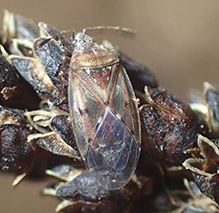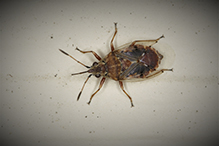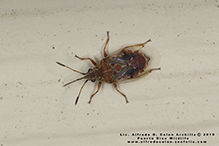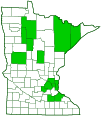birch catkin bug
(Kleidocerys resedae)
Conservation • Description • Habitat • Ecology • Distribution • Taxonomy
Conservation Status |
|
|||||||
| IUCN Red List | not listed |
|||||||
| NatureServe | NNR - Unranked |
|||||||
| Minnesota | not listed |
|||||||
Description |
||
Birch catkin bug is a small seed bug. It occurs in Europe, eastern Asia, and North America. Based on the number of reported sightings, it is relatively uncommon in Minnesota. However, it is probably under-reported due to its small size. Adults are ⅛″ to 3⁄16″ (4.5 to 5.5 mm) long, reddish-brown, and fairly hard-bodied. The head is longer than wide, projected forward, and densely covered with small punctures (punctate). The beak-like part of the head containing the mouth parts (rostrum) has four segments. It is short, slender, and projects downward and forward when sucking plant juices. It is tucked into a groove on the underside of the thorax when not in use. The antennae are much longer than the head but much shorter than the body. They have four segments beyond the short basal segment (scape). They are widened at the tip (clubbed). The first and fourth segments are darker than the second and third. There are two large compound eyes on the sides of the head and two small simple eyes (ocelli) on the top of the head. The exoskeletal plate covering the thorax (pronotum) is densely punctate. There are two pairs of wings, and they are held flat over the body when at rest. The front wings (hemelytra) are longer than the hind wings and much longer than the body. The exoskeletal plate between the wing bases (scutellum), is large, triangular and reddish-brown at the tip. The hemelytra have a thickened part at the base and a thin, membranous, mostly transparent part at the tip, with a clear dividing line between the two. The thickened part is comprised of narrow area (clavus) behind the scutellum when the wings are closed and the broad marginal area (corium). At the end of the corium there is a small but distinct triangular area (cuneus). The clavus has three rows of punctures. The corium is clear or yellowish and has several dark spots. The legs are mostly reddish-brown. The last part of the leg (tarsus), corresponding to the foot, is brownish-black and has 3 segments. The last tarsal segment has a claw at the tip. There is a pad at the base of each claw. Nymphs look like wingless adults. |
||
Size |
||
Total length: ⅛″ to 3⁄16″ (4.5 to 5.5 mm) |
||
Similar Species |
||
Habitat |
||
|
||
Ecology |
||
Season |
||
One generation per year (in Ontario) |
||
Behavior |
||
|
||
Life Cycle |
||
Adults overwinter within birch catkins in leaf litter on the ground. They emerge in early spring and lay eggs in June. |
||
Nymph Food |
||
Seeds of birch trees and shrubs |
||
Adult Food |
||
|
||
Distribution |
||||
|
Sources |
|||
| 10/9/2022 | ||||
Occurrence |
||||
|
||||
Taxonomy |
|||
Order |
Hemiptera (True bugs, Hoppers, Aphids, and Allies) | ||
Suborder |
Heteroptera (True Bugs) | ||
Infraorder |
Pentatomomorpha | ||
Superfamily |
Lygaeoidea (seed bugs and allies) | ||
Family |
Lygaeidae (seed bugs) | ||
Subfamily |
Ischnorhynchinae | ||
Genus |
Kleidocerys | ||
Subordinate Taxa |
|||
birch catkin bug (Kleidocerys resedae fuscomaculatus) birch catkin bug (Kleidocerys resedae geminatus) birch catkin bug (Kleidocerys resedae resedae) |
|||
Synonyms |
|||
Lygaeus resedae |
|||
Common Names |
|||
birch catkin bug |
|||
Glossary
Corium
The thickened basal portion of the front wing that lies between the clavus and the membrane of insects in the family Hemiptera. Plural: coria.
Cuneus
The triangular, hardened, horn-like tip of the forewing of a plant bug (family Miridae).
Hemelytron
The forewing of true bugs (order Hemiptera), thickened at the base and membranous at the tip. Plural: hemelytra.
Ocellus
Simple eye; an eye with a single lens. Plural: ocelli.
Pronotum
The exoskeletal plate on the upper side of the first segment of the thorax of an insect.
Punctate
Dotted with pits (punctures), translucent sunken glands, or colored spots of pigment.
Rostrum
The stiff, beak-like projection of the carapace or prolongation of the head of an insect, crustacean, or cetacean.
Scutellum
The exoskeletal plate covering the rearward (posterior) part of the middle segment of the thorax in some insects. In Coleoptera, Hemiptera, and Homoptera, the dorsal, often triangular plate behind the pronotum and between the bases of the front wings. In Diptera, the exoskeletal plate between the abdomen and the thorax.
Tarsus
On insects, the last two to five subdivisions of the leg, attached to the tibia; the foot. On spiders, the last segment of the leg. Plural: tarsi.
Visitor Photos |
|||||
Share your photo of this insect. |
|||||
| This button not working for you? Simply email us at info@MinnesotaSeasons.com. Attach one or more photos and, if you like, a caption. |
|||||
Babette Kis |
|||||
Birch catkin seed bug, Kleidocerys resedae Kleidocerys resedae, Birch catkin seed bug, on blue vervain, verbena hastata, seed spike. Barnes Prairie, Racine Co., WI, photo taken November 9, 2020. |
 |
||||
Alfredo Colon |
|||||
 |
 |
||||
MinnesotaSeasons.com Photos |
|||||
|
|||||

Slideshows |
||

Visitor Videos |
|||
Share your video of this insect. |
|||
| This button not working for you? Simply email us at info@MinnesotaSeasons.com. Attach a video, a YouTube link, or a cloud storage link. |
|||
Other Videos |
|||
| Kleidocerys resedae - Birch Catkin Bug Maria Hellström |
|||
About
Jun 1, 2016 |
|||


Created: 2/17/2020
Last Updated:


